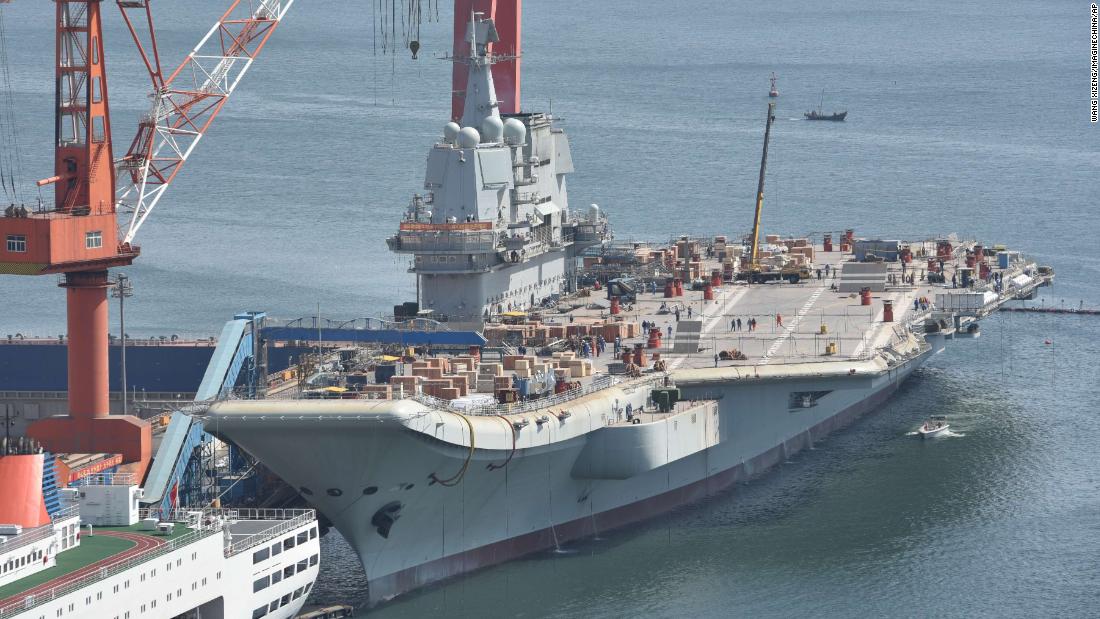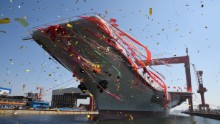[ad_1]
The new aircraft carrier, temporarily named Type 001A, sailed out at around 7 a.m. in Dalian, in the northeast province of Liaoning, according to reports in Chinese state media.
The 50,000-tonne ship will become the country’s second aircraft carrier, and the first to be entirely built and designed inside of China, when it joins the navy sometime before 2020.
But experts said while the new aircraft carrier will dramatically boost China’s military power in the Asia region, its technology was still outdated and lagged far behind the world’s naval superpower, the United States.
“This is, in and of itself, not designed to be some frontal challenge to US power in the Asia Pacific, because it simply isn’t in the class of America’s aircraft carriers,” Sam Roggeveen, senior fellow at Sydney’s Lowy Institute, told CNN.
Bigger and better
China’s second aircraft carrier will be “modernized” compared to its first, experts said, with a design that’s bigger and heavier to allow it to carry more planes.
The basic design for the new aircraft carrier is clearly modeled heavily on the Liaoning, including the signature ski-jump inclination at the front from which aircraft lift off.
The ship, which is roughly 315 meters (1,033 ft) in length and 75 meters (246 ft) wide, uses conventional rather than nuclear propulsion, and is believed to displace 50,000 tonnes, according to reports in state media.
Speaking to CNN, RAND Corporation senior international defense research analyst Timothy Heath described the design as generally easier to build and to operate aircraft from.
But expert analysis of pictures and satellite images of the new China-built vessel reveals it has been altered in subtle ways, possibly allowing it to accommodate up to eight additional aircraft.
By comparison, the Liaoning is thought to currently carry around 30 warplanes, including fixed wing aircraft and helicopters.
According to Peter Layton, visiting fellow at the Griffith Asia Institute, the Liaoning was intended to act as more of a training vessel, whereas the new ship is likely to be deployed in combat missions, positioning China alongside a select number of countries with global naval capabilities, including Russia, France, the United States, and the United Kingdom.
As of this year, the United States Navy fields 11 nuclear-powered aircraft carriers, more than any other nation in the world.
The US ships feature “catapult” technology, in which a gear attached to a steam-powered piston or an electromagnetic rail gets aircraft up to flight speed as they leave the deck.
Aircraft launched by catapults can get airborne and with greater quantities of fuel and ammunition, giving them an advantage over Chinese planes, which rely on their own power when lifting off from the Liaoning’s ski-jump.
Still more sea trials needed
Once an aircraft carrier passes its sea trials, that doesn’t mean it’s ready for combat. Although the type 001A has successfully left the ship yard, plenty of problems can, and most likely will, arise.
In the United States, the USS Gerald R Ford, the US Navy’s newest carrier and the most expensive warship ever built at $13 billion, has a host of problems.
The Ford was commissioned into the fleet in July 2017, however, a January 2018 report from the Pentagon’s Operational Test and Evaluation Office says the 100,000-ton warship is plagued with troubles in critical systems, including its catapults that launch planes, the arresting gear which catches them upon landing, and its radar.
Those deficiencies “make the ship more vulnerable to attack, or create limitations during routine operations,” the report said.
Other problems are more mundane, but show just how many things have to be ironed out in a new warship: The test office report says the Ford is expected to be short of spaces for its crew to sleep.
Future of the Chinese navy
China may still be a long way from presenting a global challenge to the US Navy, but as a regional power its military program is moving fast.
Between 2010 and 2017, the Chinese Navy increased its complement of ships from 210 to 320, Boston College professor of political science Robert Ross told CNN, including another 18 in 2016 alone.
By comparison, the active US fleet currently sits at approximately 272 ships, he said.
“The US Navy and the capability for the US Navy will still be superior to the Chinese Navy in 10 years, but the size of the Chinese fleet will be larger and they’ll have closed the gap in technology and training,” Ross said.
“If you look at China’s acquisitions of facilities in the Indian Ocean and in Eastern Africa, they’re quickly developing the capability to maintain a naval presence in distant waters,” Ross said.
Still, the main focus of the PLA Navy in the near future is expected to be dominating the waters around the Chinese mainland, including the South China Sea.
China is fortifying islands in the region with facilities that could host military aircraft, creating what some experts have called “unsinkable aircraft carriers.”
Compared to the rest of the Asia region, Ross said, only Japan can currently equal the Chinese navy and even then they probably only had about five years before they too would be surpassed.
[ad_2]
Source link





